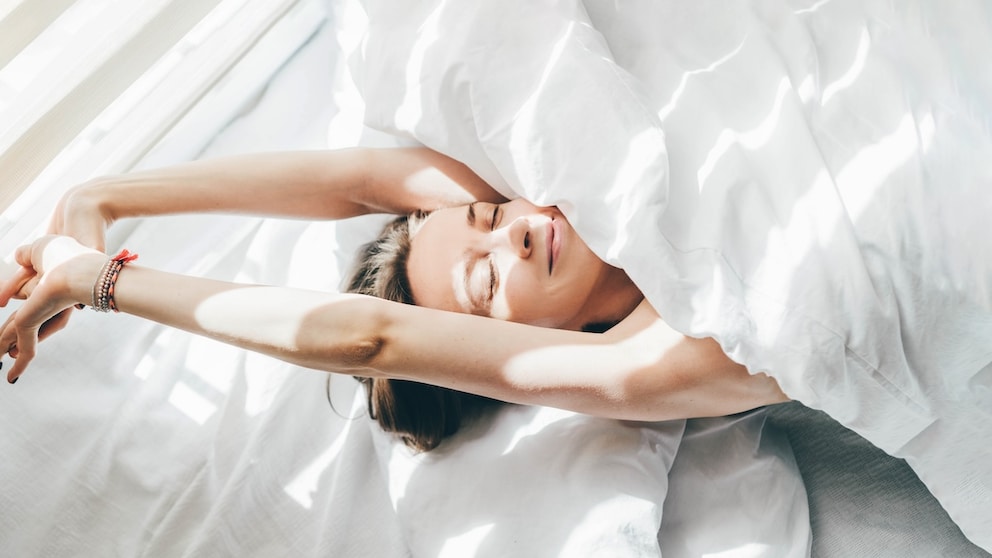March 18, 2025, 2:18 pm | Read time: 5 minutes
Would you also like to improve your sleep? Then you are like countless people around the world. Various habits and measures are known to improve the quality of sleep, but of course, individual experience can also play a role. The social media trend “Sleepmaxxing” goes a few steps further. FITBOOK author Laura Pomer introduces it — and reveals what an expert thinks.
There are various recommendations for healthy sleep, some of which have been proven by research. Among other things, exercises can help you find the relaxation you need before going to bed. Diet also influences sleep. But there is more you can do. Much more! Followers of the “Sleepmaxxing” social media trend are creating a veritable cult around improving the quality of sleep.
Overview
What Is Behind “Sleepmaxxing”?
“Sleepmaxxing” is a combination of the English word for sleep, “sleep,” and “maxxing” — a derivation of the term “maximizing”. In other words, “sleepmaxxing” means that you want to bring your sleep to the highest level in terms of quality. The trend, therefore, addresses a major social issue. After all, sleep disorders have long been considered a widespread disease. And it is no secret that persistent sleep deprivation and difficulty sleeping through the night can have lasting detrimental effects on health.
TikTok is full of “sleepmaxxing” content. Influencers proclaim the trend and sometimes share personal tips to further optimize sleep.
How It Works
On the whole, it’s about establishing fixed routines. According to “Sleepmaxxing,” it’s crucial to consistently go to bed and wake up at the same time. The instructions are divided into different phases.
The Hours Before Going to Bed
It is recommended that you refrain from consuming caffeine from the afternoon onward. Alcohol should generally be avoided so as not to impair the quality of sleep.
Supporters of the trend urge people to avoid sitting in front of a screen in the last hour before going to bed. If there is no other option, for example, if you have to work on a laptop, they recommend wearing glasses with a blue light filter. As a reminder, it is assumed that the blue light from smartphone and laptop screens inhibits the release of the sleep hormone melatonin. Routine walks before going to bed, or alternatively, meditation or yoga, should help you to shake off your thoughts and any stress from the day and calm down.
Recommended Sleeping Environment
The temperature in the bedroom should be between 16 and 20 degrees Celsius. According to “Sleepmaxxing” fans, you should also air the room thoroughly before going to bed. Some say that the room should be well-darkened. Others swear by the use of red light lamps, and others cannot do without a sleep mask. Additionally, videos frequently emphasize the importance of selecting the right mattress for a good night’s sleep.
What a Sleep Doctor Says About “Sleepmaxxing”
FITBOOK asked sleep physician Dr. med Michael Feld what he thinks of the social media trend. “In principle, they are all reasonably sensible approaches,” he says — and it is definitely advantageous that the principle of “Sleepmaxxing” combines various measures. The doctor himself also proceeds in the same way when treating patients with sleep problems. You have to prepare a menu, so to speak, and “make a nice bed for sleep.” The reality is that sleep cannot be simply willed into existence; alternative strategies are necessary.
In summary, these are classic sleep hygiene measures with certain additions. In principle, the expert rates “Sleepmaxxing” positively as a lifestyle measure and, according to Dr. Feld, “Sleepmaxxing” can possibly provide relief to a certain degree of sleep disorders. However, he believes that it offers no benefit for more severe sleep-related issues.
Some (Overly) Far-Reaching Recommendations?
The “Sleepmaxxing” approach is in line with the recommendations of sleep researchers, at least on several points. However, the self-proclaimed experts on TikTok and co. often give additional advice. For example, they recommend eating two kiwis before going to bed, as this is said to have a positive effect on the psyche and promote sleep. Taking dietary supplements, especially muscle-relaxing magnesium, is also advised. Another tip: “Mouth taping,” i.e., closing the mouth with adhesive tape. This is said to promote nasal breathing, which is known to have a positive effect on the oxygen supply.1 However, there is insufficient scientific evidence of the effect of mouth taping in particular.

When a hangover is excluded Headaches in the morning? The possible causes at a glance

Study Shows Even One Night with Too Little Sleep Can Promote Inflammation

Relaxation exercises, yoga, reflection What anxiety disorders there are, and what you can do about them
What You Should Always Bear in Mind
Practicing a certain amount of sleep hygiene is certainly sensible per se. That’s why there are various recommendations from experts such as Dr. Feld or the psychologist Dr. Hans-Günter Weeß, who gave FITBOOK twelve valuable tips in this article on how to fall asleep and sleep through the night better. One of them, by the way, is not to get too hung up on the subject of sleep. Attempting to compensate for a restless night with force can reintroduce stress — which is, of course, counterproductive to achieving restful sleep.
This advice can also be applied to an excessive focus on sleep optimization through “Sleepmaxxing.” Obsessing over perfect sleep and ample sleep duration can induce stress, potentially leading to the very issue one wishes to avoid: sleep disorders. If possible, you should try to take a relaxed approach to the topic of sleep. However, if there are serious sleep disorders, a specialist should be consulted.

